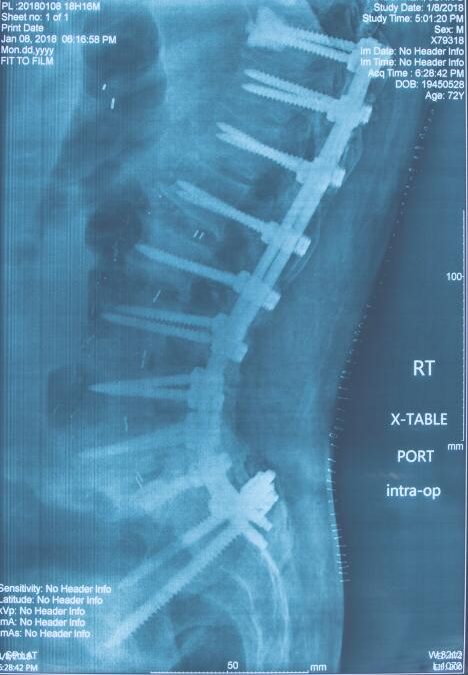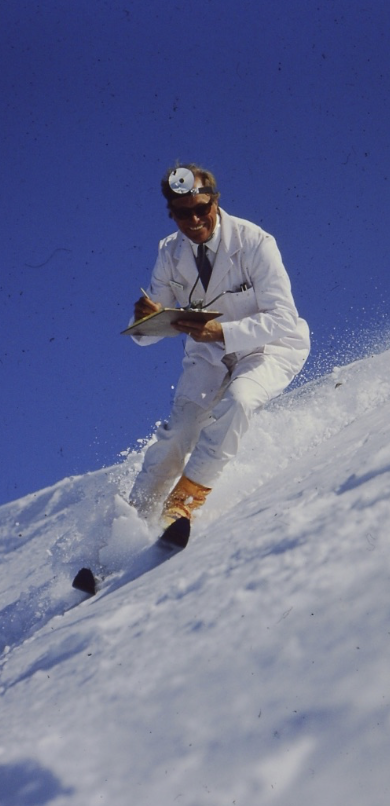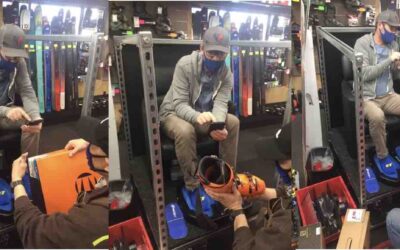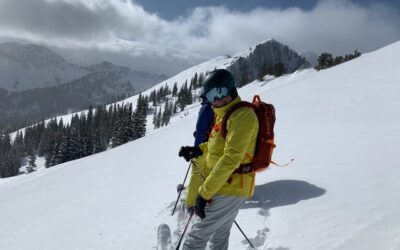To describe skiers as a resilient lot wouldn’t be wrong, just woefully insufficient.
Skiers are determined to ski no matter how many battles with gravity they have lost. Many have been brutally mauled, patched back together and hustled back into the fray while their most recent wounds are still healing.
Take a good look at the x-ray decorating this page. Supplementing the efforts of what was once a normal human spinal column is a spiral staircase of what appear to be 4-inch wood screws. As repairs go, it’s not what one would consider subtle or sophisticated.
It belongs, of course, to a lifelong skier, one who until recently still suited up and sallied forth, not just to ski, but to teach skiing to the general public. This level of determination derives from a place beyond obsession, somewhere in the neighborhood of insanity.
By the way, this isn’t the only hardware that’s been welded to skeletal remains in this skier’s mortal coil. There’s a nifty metal plate anchoring the left wrist, as well. Based on the testimony I’ve received from Realskiers’ membership, any skier past the age of 50 who has had one traumatic skiing injury has most likely had several. None that I know of has ever even considered leaving the sport simply due to a concatenation of injuries.
Among the miracles of modern medicine that have made it possible for skiers to carry on are the improvements made in the field of joint replacement. It’s become a standard element in the brief autobiographies that serve as necessary prelude to any discussion about ski selection. For example, “I ski mostly in the East but take at least one trip to a western resort every winter, like to ski fast in all conditions, stand 6”1”, weigh 190 pounds, am reasonably fit and have had 3 joints replaced: two knees and a shoulder.”
The details of joint replacement are Civil-War era gruesome, but the results are usually brilliant, as in skiing without pain for the first time in decades. If there is a lesson about the advisability of joint replacement to be extracted from my correspondence, it is to stop dithering and do it.
Believe it or not, the following snapshots of injury (and recovery) are typical. The first vignette comes from an industry insider whose back “went completely south end of last winter…couldn’t walk more than 20 feet without keeling over, always hunched over, shuffling everywhere in agony. I really related to not being able to lay still in an MRI…my MRI images were shit because I just couldn’t do it even on heavy pain and muscle relaxer meds. One of the most miserable experiences in my plentiful health history.”
The fix for all this skeletal havoc was a “triple level fusion (L5-L3…probably also should have been S1, but didn’t for now), 4 discectomies and 5 laminectomies all in 1 shot.” The accumulated damage wasn’t due to “any one big incident that I recall, just years of being an idiot. I guess racing motorcycles, snowmobiling and skiing finally took its toll… Still recovering 5 months later, but I’ll be back on snow for the first time next week for some product testing.” You just can’t keep a good man down.
Another Realskiers correspondent who confessed to three spinal fusions hastened to note that these were “in addition to 5 shoulder surgeries along with 2 joint replacements and last year’s ACL replacement.” It took another Realskiers subscriber seventy years to log this litany of woe:
four knee surgeries prior to two total knee replacements, a broken neck (C7), herniated disc (L4-L5), and a separated shoulder repair, but otherwise fine.” I love the “otherwise fine,” as though all the surgeries were minor inconveniences.
As I look back on my own history of skeletal re-assembly, I consider myself lucky to have escaped with an ACL reconstruction, four laminectomies, two epidurals on C2/C3 and the lumbar fusion (L3 – L5) that I’m still nursing (PT is probably 6 weeks away). That may sound like a lot of time in the repair shop, but considering where and how I have chosen to ski over the past seven decades, I got off light.
Here’s the thing about skiing: once you experience the exhilaration and joy that skiing makes possible, you will do anything in your power to keep doing it. If all skiing had going for it was a high rate of traumatic injury, we wouldn’t be any better at recruiting fresh blood than the Amish. But properly practiced, skiing is as much about spiritual nourishment as it is technical proficiency. Skiing offers a portal to another side of ourselves, a chance to disappear into the moment, to be one with the mountain and our movements. This is why we must keep coming back. This is why we ski.
Related Articles
Cascading Rivulets of Thought
As the photo above attests, I've been composing my thoughts about skis and skiing for a long time. This week's Revelation recaps the 2020/21 season as captured in the pages of...
How Not to Buy Ski Boots
Of all the nefarious practices in our little business, none is more inimical than a consumer shopping a website for price while extracting the vitally important technical expertise from a...
52 Weeks
Your Esteemed Editor en route to his next descent in the Wasatch backcountry. If you’re a skier, and you believe in the afterlife, this is where you wind up. (Provided you’ve been very, very good.)...






